The latest and greatest television technology was unveiled at the recent 2023 Consumer Electronics Show (CES), the eagerly anticipated affair presented by the Consumer Technology Association. In case you missed the show, stay tuned for a few notable highlights.
Televisions have come a long way since Paris in 1909, the setting of the first demonstration of live transmission of still images by Georges Rignoux and A. Fournier, who were able to transmit the letters of the alphabet via a crude Kerr cell receiver. Scientists and inventors around the world undertook efforts to improve upon this system, and in 1926, after years of effort, John Logie Baird gave the first demonstration of what would become the television.






